Global Nanocapsules Market, By Type, By Application, By Region & Segmental Insights Trends and Forecast, 2024 – 2034
- Industry: Healthcare
- Report ID: TNR-110-1309
- Number of Pages: 420
- Table/Charts : Yes
- September, 2024
- Base Year : 2024
- No. of Companies : 10+
- No. of Countries : 29
- Views : 10082
- Covid Impact Covered: Yes
- War Impact Covered: Yes
- Formats : PDF, Excel, PPT
Nanocapsules are nano-sized carriers made from biocompatible materials, designed to encapsulate active substances. The global nanocapsules market has gained importance due to its ability to improve the delivery of drugs, nutrients, and chemicals in a controlled and targeted manner. This technology ensures enhanced stability, reduces side effects, and improves efficiency in various applications.
For instance, in the pharmaceutical industry, nanocapsules are used for targeted drug delivery, allowing medications to reach specific tissues. In cosmetics, they enhance the absorption of active ingredients like vitamins. In agriculture, nanocapsules protect pesticides from degradation, ensuring slow, controlled release over time.
Nanocapsules are created through processes like coacervation, solvent evaporation, or layer-by-layer assembly. By 2023, this market witnessed substantial growth due to advancements in healthcare and agriculture, with increased research driving its widespread adoption across multiple industries. In Terms of Revenue, the Global Nanocapsules Market was Worth US$ 3.9 Bn in 2023, Anticipated to Witness CAGR of 6.2% During 2024 – 2034.
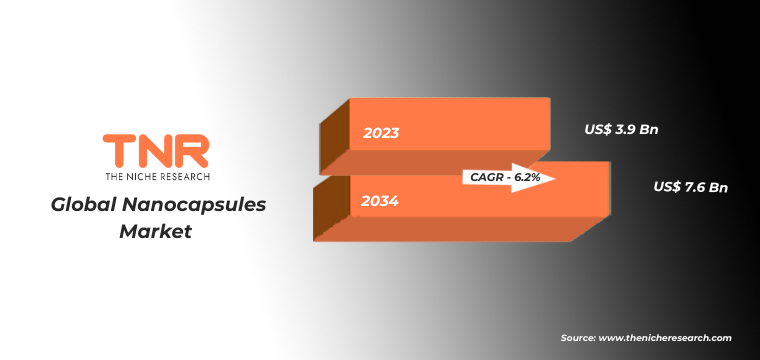
| Feature | Polymeric Nanocapsules | Lipid Nanocapsules | Protein-Based Nanocapsules | Inorganic Nanocapsules | Others |
| Composition | Synthetic or natural polymers (e.g., PLA, PLGA) | Lipids (e.g., phospholipids, triglycerides) | Proteins (e.g., albumin, gelatin) | Inorganic materials (e.g., silica, gold) | Various materials (e.g., dendrimers, metals) |
| Properties | Biodegradable, controlled release, versatile | Biocompatible, enhances stability, controlled release | High biocompatibility, biodegradable | Stable, customizable properties (magnetic, optical) | Tailored properties depending on materials |
| Encapsulation Capacity | Hydrophilic and hydrophobic drugs | Lipophilic substances | Therapeutic proteins and peptides | Various types, including hydrophobic and hydrophilic | Dependent on specific type |
| Applications | Drug delivery (e.g., cancer therapy), vaccines | Cosmetics (e.g., anti-aging creams), pharmaceuticals | Drug delivery (e.g., anticancer drugs), biomedical applications | Imaging (e.g., MRI, CT scans), diagnostics, drug delivery | Specialized applications (e.g., gene delivery) |
| Examples | PLGA-based nanocapsules for cancer therapy | Lipid nanocapsules in anti-aging creams by L’Oréal | Albumin-based nanocapsules for targeted cancer therapy | Silica nanocapsules for enhanced imaging in diagnostics | Dendritic nanocapsules for gene therapy |
| Advantages | Reduces side effects, enhances drug efficacy | Improves stability and absorption of lipophilic substances | Maintains stability of sensitive proteins, targeted delivery | Customizable for specific functions, high stability | Highly customizable for various functions |
Growth Drivers in the Global Nanocapsules Market
- Advancements in Drug Delivery Systems: The rising need for efficient drug delivery systems has driven the growth of nanocapsules in pharmaceuticals. By 2023, nanocapsules were increasingly used for targeted therapy, minimizing side effects and improving patient outcomes in treatments like cancer and chronic diseases.
- Growing Demand in Cosmetic Industry: Nanocapsules have revolutionized the cosmetic industry by enhancing the stability and penetration of active ingredients. In 2022, products like anti-aging creams and sunscreens benefited from nanocapsules, offering better skin absorption and longer-lasting effects, boosting the market.
- Agricultural Efficiency Improvements: Nanocapsules help in the slow release of pesticides and fertilizers, reducing environmental impact and enhancing crop protection. By 2023, their integration in sustainable farming practices saw increased adoption, especially in Asia, where agricultural productivity is a key focus.
Restraints in the Global Nanocapsules Market
- High Production Costs: The complex manufacturing processes of nanocapsules, such as coacervation or solvent evaporation, make production expensive. In 2023, small pharmaceutical and cosmetic companies faced challenges in adopting nanocapsule technology due to the high costs associated with large-scale production.
- Regulatory Challenges: The global nanocapsules market faces strict regulatory scrutiny. By 2022, companies in the pharmaceutical and agricultural sectors encountered delays in product approvals due to safety and efficacy concerns, hindering market expansion, particularly in regions like Europe and North America.
- Limited Consumer Awareness: Despite their benefits, consumer awareness about nanocapsules in products like cosmetics and food remains limited. In 2023, a lack of understanding regarding nanotechnology’s advantages prevented widespread adoption, particularly in emerging markets where education and outreach efforts were insufficient.
Global Nanocapsules Market Segmental Analysis
By Type-
Lipid nanocapsules have become the leading product type in the global nanocapsules market, holding a 30.8% revenue share by 2023. Their biocompatibility and capacity for controlled drug delivery make them ideal for various applications. In 2022, lipid nanocapsules were widely used in cancer treatment for delivering chemotherapeutic drugs, minimizing side effects by targeting only cancerous cells. Similarly, in cosmetics, brands like L’Oréal employed lipid nanocapsules in anti-aging creams to enhance skin penetration of active ingredients like retinol. In the food industry, lipid nanocapsules were integrated into functional beverages to encapsulate vitamins and nutrients, improving bioavailability. These widespread applications have driven the dominance of lipid nanocapsules across healthcare, beauty, and food sectors.
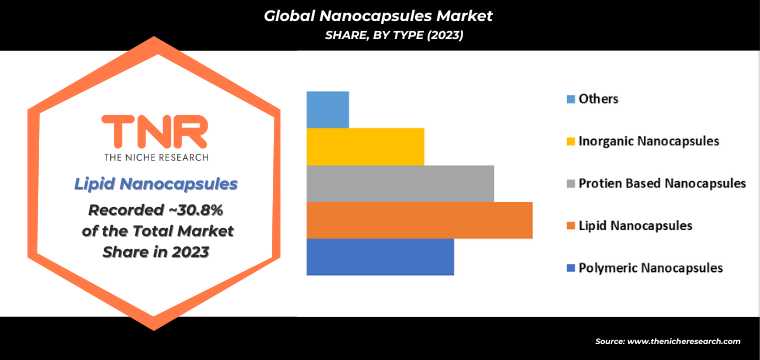
By Application-
In 2023, the agriculture segment became the second-largest application category in the global nanocapsules market, capturing 21.5% of the revenue share. Nanocapsules in agriculture are widely used for controlled release of pesticides and fertilizers, enhancing efficiency while reducing environmental impact. For example, in India, nanocapsules were employed in pesticide formulations, ensuring gradual release and improved pest control over time. Similarly, in Brazil, nanocapsules were introduced in fertilizers to deliver nutrients directly to plant roots, boosting crop yields. Their ability to protect active ingredients from degradation and deliver them in a targeted manner has made nanocapsules crucial for sustainable agriculture practices globally. By 2023, their adoption in precision farming and pest management significantly increased, further driving market growth.
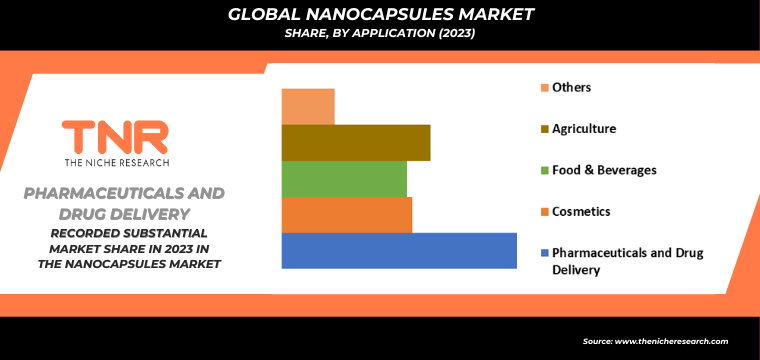
By Region-
In 2023, North America reinforced its leadership in the global nanocapsules market, claiming a substantial 37.2% revenue share. The region’s dominance is driven by advancements in pharmaceuticals, where nanocapsules are used for targeted drug delivery. For example, U.S.-based companies like Pfizer incorporated nanocapsule technology in cancer treatments, enhancing the effectiveness of chemotherapy by targeting cancer cells directly. Additionally, North American agricultural firms, such as Corteva Agriscience, adopted nanocapsules to improve the precision of pesticide and fertilizer applications. The region also saw significant growth in cosmetics, where brands like Estée Lauder utilized nanocapsules to deliver anti-aging compounds more effectively. North America’s strong research infrastructure and innovation continue to push the boundaries of nanocapsule applications.
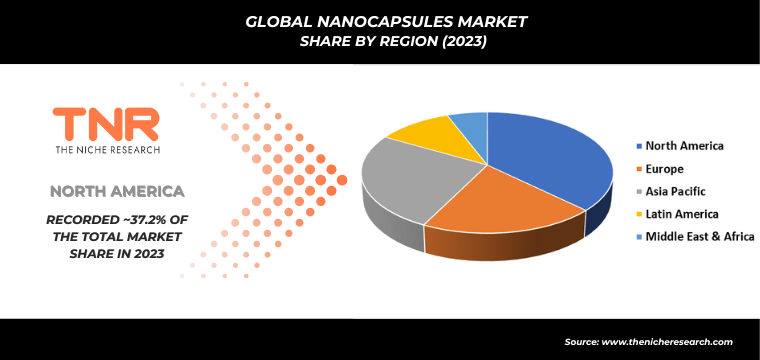
Competitive Landscape
Some of the players operating in the nanocapsules market are
- BioDelivery Sciences
- Camurus
- Carlina Technologies
- Cerulean Pharma Inc.
- Eos Biosciences, Inc.
- GAT Food Essentials
- Nano Green Sciences, Inc.
- NanoNutra
- NanoSphere Health Science
- PolyMicrospheres
- Other Industry Participants
Global Nanocapsules Market Scope:
| Report Specifications | Details |
| Market Revenue in 2023 | US$ 3.9 Bn |
| Market Size Forecast by 2034 | US$ 7.6 Bn |
| Growth Rate (CAGR) | 6.2% |
| Historic Data | 2016 – 2022 |
| Base Year for Estimation | 2023 |
| Forecast Period | 2024 – 2034 |
| Report Inclusions | Market Size & Estimates, Market Dynamics, Competitive Scenario, Trends, Growth Factors, Market Determinants, Key Investment Segmentation, Product/Service/Solutions Benchmarking |
| Segments Covered | By Type, By Application, By Region |
| Regions Covered | North America, Europe, Asia Pacific, Middle East & Africa, Latin America |
| Countries Covered | U.S., Canada, Mexico, Rest of North America, France, The UK, Spain, Germany, Italy, Nordic Countries (Denmark, Finland, Iceland, Sweden, Norway), Benelux Union (Belgium, The Netherlands, Luxembourg), Rest of Europe, China, Japan, India, New Zealand, Australia, South Korea, Southeast Asia (Indonesia, Thailand, Malaysia, Singapore, Rest of Southeast Asia), Rest of Asia Pacific, Saudi Arabia, UAE, Egypt, Kuwait, South Africa, Rest of Middle East & Africa, Brazil, Argentina, Rest of Latin America |
| Key Players | BioDelivery Sciences, Camurus, Carlina Technologies, Cerulean Pharma Inc., Eos Biosciences, Inc., GAT Food Essentials, Nano Green Sciences, Inc., NanoNutra, NanoSphere Health Science, PolyMicrospheres |
| Customization Scope | Customization allows for the inclusion/modification of content pertaining to geographical regions, countries, and specific market segments. |
| Pricing & Procurement Options | Explore purchase options tailored to your specific research requirements |
| Contact Details | Consult With Our Expert
Japan (Toll-Free): +81 663-386-8111 South Korea (Toll-Free): +82-808- 703-126 Saudi Arabia (Toll-Free): +966 800-850-1643 United Kingdom: +44 753-710-5080 United States: +1 302-232-5106 E-mail: askanexpert@thenicheresearch.com
|
Key Developments:
- In September 2020, Sol-Gel announced that the FDA had approved its New Drug Application (NDA) for Epsolay, a topical cream intended to treat inflammatory lesions associated with rosacea.
- In August 2017, Jazz Pharmaceuticals, Inc. received FDA approval for Vyxeos, a liposomal encapsulated combination of daunorubicin and cytarabine, aimed at treating adults with newly diagnosed acute myeloid leukemia (AML).
Global Nanocapsules Market
By Type
- Polymeric Nanocapsules
- Lipid Nanocapsules
- Protein Based Nanocapsules
- Inorganic Nanocapsules
- Others
By Application
- Pharmaceuticals and Drug Delivery
- Cosmetics
- Skin Care
- Hair Care
- Others
- Food & Beverages
- Encapsulation of Nutrients
- Flavor and Color Preservation
- Others
- Agriculture
- Pesticide Delivery
- Fertilizer Encapsulation
- Others
- Others
By Region
- North America (U.S., Canada, Mexico, Rest of North America)
- Europe (France, The UK, Spain, Germany, Italy, Nordic Countries (Denmark, Finland, Iceland, Sweden, Norway), Benelux Union (Belgium, The Netherlands, Luxembourg), Rest of Europe)
- Asia Pacific (China, Japan, India, New Zealand, Australia, South Korea, Southeast Asia (Indonesia, Thailand, Malaysia, Singapore, Rest of Southeast Asia), Rest of Asia Pacific)
- Middle East & Africa (Saudi Arabia, UAE, Egypt, Kuwait, South Africa, Rest of Middle East & Africa)
- Latin America (Brazil, Argentina, Rest of Latin America)
Report Layout:
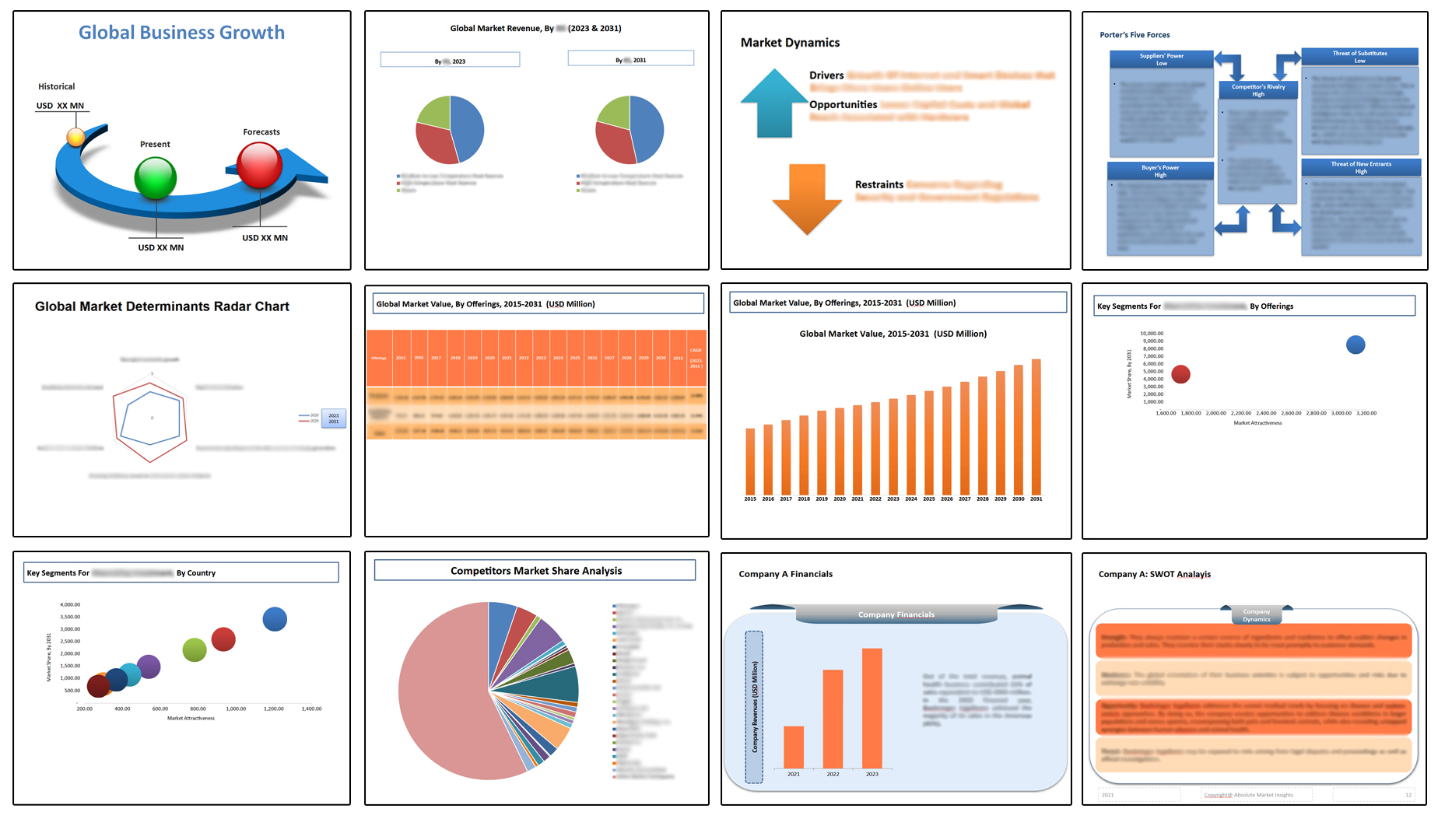
Table of Contents
Note: This ToC is tentative and can be changed according to the research study conducted during the course of report completion.
**Exclusive for Multi-User and Enterprise User.
Global Nanocapsules Market
By Type
- Polymeric Nanocapsules
- Lipid Nanocapsules
- Protein Based Nanocapsules
- Inorganic Nanocapsules
- Others
By Application
- Pharmaceuticals and Drug Delivery
- Cosmetics
- Skin Care
- Hair Care
- Others
- Food & Beverages
- Encapsulation of Nutrients
- Flavor and Color Preservation
- Others
- Agriculture
- Pesticide Delivery
- Fertilizer Encapsulation
- Others
- Others
By Region
- North America (U.S., Canada, Mexico, Rest of North America)
- Europe (France, The UK, Spain, Germany, Italy, Nordic Countries (Denmark, Finland, Iceland, Sweden, Norway), Benelux Union (Belgium, The Netherlands, Luxembourg), Rest of Europe)
- Asia Pacific (China, Japan, India, New Zealand, Australia, South Korea, Southeast Asia (Indonesia, Thailand, Malaysia, Singapore, Rest of Southeast Asia), Rest of Asia Pacific)
- Middle East & Africa (Saudi Arabia, UAE, Egypt, Kuwait, South Africa, Rest of Middle East & Africa)
- Latin America (Brazil, Argentina, Rest of Latin America)
The Niche Research approach encompasses both primary and secondary research methods to provide comprehensive insights. While primary research is the cornerstone of our studies, we also incorporate secondary research sources such as company annual reports, premium industry databases, press releases, industry journals, and white papers.
Within our primary research, we actively engage with various industry stakeholders, conducting paid interviews and surveys. Our meticulous analysis extends to every market participant in major countries, allowing us to thoroughly examine their portfolios, calculate market shares, and segment revenues.
Our data collection primarily focuses on individual countries within our research scope, enabling us to estimate regional market sizes. Typically, we employ a bottom-up approach, meticulously tracking trends in different countries. We analyze growth drivers, constraints, technological innovations, and opportunities for each country, ultimately arriving at regional figures.Our process begins by examining the growth prospects of each country. Building upon these insights, we project growth and trends for the entire region. Finally, we utilize our proprietary model to refine estimations and forecasts.
Our data validation standards are integral to ensuring the reliability and accuracy of our research findings. Here’s a breakdown of our data validation processes and the stakeholders we engage with during our primary research:
- Supply Side Analysis: We initiate a supply side analysis by directly contacting market participants, through telephonic interviews and questionnaires containing both open-ended and close-ended questions. We gather information on their portfolios, segment revenues, developments, and growth strategies.
- Demand Side Analysis: To gain insights into adoption trends and consumer preferences, we reach out to target customers and users (non-vendors). This information forms a vital part of the qualitative analysis section of our reports, covering market dynamics, adoption trends, consumer behavior, spending patterns, and other related aspects.
- Consultant Insights: We tap into the expertise of our partner consultants from around the world to obtain their unique viewpoints and perspectives. Their insights contribute to a well-rounded understanding of the markets under investigation.
- In-House Validation: To ensure data accuracy and reliability, we conduct cross-validation of data points and information through our in-house team of consultants and utilize advanced data modeling tools for thorough verification.
The forecasts we provide are based on a comprehensive assessment of various factors, including:
- Market Trends and Past Performance (Last Five Years): We accurately analyze market trends and performance data from preceding five years to identify historical patterns and understand the market’s evolution.
- Historical Performance and Growth of Market Participants: We assess the historical performance and growth trajectories of key market participants. This analysis provides insights into the competitive landscape and individual company strategies.
- Market Determinants Impact Analysis (Next Eight Years): We conduct a rigorous analysis of the factors that are projected to influence the market over the next eight years. This includes assessing both internal and external determinants that can shape market dynamics.
- Drivers and Challenges for the Forecast Period:Identify the factors expected to drive market growth during the forecast period, as well as the challenges that the industry may face. This analysis aids in deriving an accurate growth rate projection.
- New Acquisitions, Collaborations, or Partnerships: We keep a close watch on any new acquisitions, collaborations, or partnerships within the industry. These developments can have a significant impact on market dynamics and competitiveness.
- Macro and Micro Factors Analysis:A thorough examination of both macro-level factors (e.g., economic trends, regulatory changes) and micro-level factors (e.g., technological advancements, consumer preferences) that may influence the market during the forecast period.
- End-User Sentiment Analysis: To understand the market from the end-user perspective, we conduct sentiment analysis. This involves assessing the sentiment, preferences, and feedback of the end-users, which can provide valuable insights into market trends.
- Perspective of Primary Participants: Insights gathered directly from primary research participants play a crucial role in shaping our forecasts. Their perspectives and experiences provide valuable qualitative data.
- Year-on-Year Growth Trend: We utilize a year-on-year growth trend based on historical market growth and expected future trends. This helps in formulating our growth projections, aligning them with the market’s historical performance.
Research process adopted by TNR involves multiple stages, including data collection, validation, quality checks, and presentation. It’s crucial that the data and information we provide add value to your existing market understanding and expertise. We have also established partnerships with business consulting, research, and survey organizations across regions and globally to collaborate on regional analysis and data validation, ensuring the highest level of accuracy and reliability in our reports.









